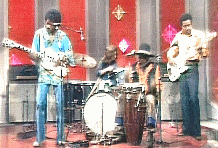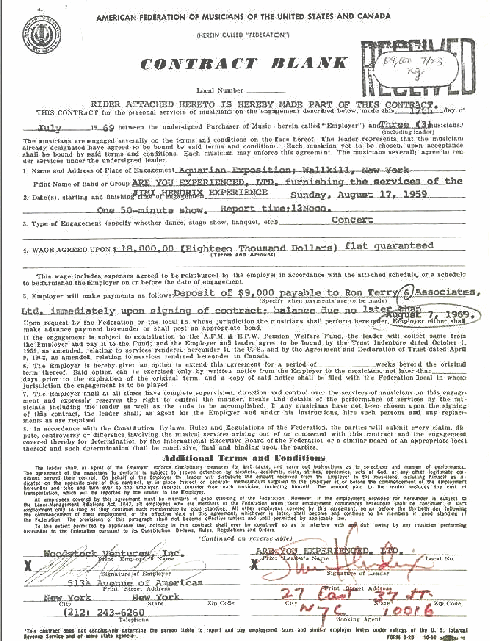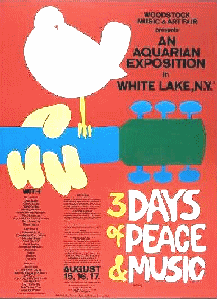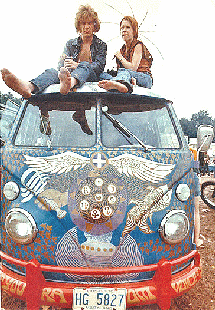 |
  |
 |
published: August 2, "1994"
Jimi Hendrix :Woodstock CD booklet by Michael Fairchild |

What's New & Previews
Jimi's Prediction —
A Remote View About Jimi Hendrix Timeline Blog Asteroid Impact Evolution Woodstock Blues Jimi Code VS. Da Vinci Code Credit Thefts Missile Agency/Moon Base Charade Remote View Mutation Seattleland Censorship Events Skewed Science Search Engine Rankings Download An Ad AT&T: New Nuremberg Wall(y)flower Syndrome Rochester Media DVD/CD Store More Links... 
page 2 of 8
While preparations for Woodstock hit high gear in April, the Jimi Hendrix Experience embarked on their final American tour. Booked into the nation's largest arenas, the trio had emerged at the top of the rockpile by reaping record-breaking fees for their gigs. At a time when each of the other 30 groups slated for Woodstock were accepting various fees well below $16,000, the producers had earmarked $50,000 specifically for Jimi, just in case that's what it took to top the bill properly. Still, that amount was only half of what the Experience earned on a good night in '69.
When the group finished touring in late June, bassist Noel Redding resigned. "The Experience got into a cul-de-sac," Hendrix said to the press, "we played for three years and reached the stage where we were just repeating ourselves."
Return to Dick Cavett Show - Sept. 1969
On July 7 Jimi jammed with the Jack Rosenbaum Orchestra when he made his American TV debut on ABC's Dick Cavett Show. Three days later Hendrix was a guest on NBC's Tonight Show, but for this appearance Billy Cox accompanied him on bass. "Jimi Hendrix Has A Brand New Bass" was a headline in the July 12 edition of Rolling Stone: "Hendrix has named an old Army buddy as the bass player he may soon be recording with and hinted...that as soon as contracts allow, the Jimi Hendrix Experience may make the transition from trio to creative commune." Billy Cox and Jimi were both paratroopers stationed at Ft. Campbell, Ky. when they met in 1961. A near telepathic musical compatibility ensured their close and lasting friendship. When the Experience broke up it was Billy that Jimi turned to first. "It's nothing personal against Noel," said Hendrix, "but we finished what we were doing with the Experience. Billy's style of playing suits the new group better. See Noel, he has his own group, and he's into his own thing...and I wanted the bottom to be just a little more solid. Noel's more of a melodic player, and Billy plays more of a solidist bass. We're doin' a lot of bass and guitar unison things, like a lot of rhythms, like patterns." Asked if he'd retain Mitch Mitchell on drums, Jimi answered, "If he wants to come along, yeah. I'll keep anybody that wants to come along, long as they're gonna be contributing to the cause. I'll keep anything necessary, and it's all gonna be strictly necessary - for the cause." He went on to describe his new musical direction as "a Sky Church sort of thing. It's best not to harp upon us - the personalities and all that. It's the whole thing, what the whole thing is trying to get across...It's a feeling first. We have this family thing we're trying to get together, and then the money will come. Nowadays, too many musicians think of the money and the image first, before they figure out what they're trying to get across."
A few days after Jimi introduced Billy on the Tonight Show, Woodstock Ventures lost their festival site to the Concerned Citizens of Wallkill, NY. While Apollo 11 raced towards the first manned lunar landing, Michael Lang raced to find a new launching pad for the Aquarian Age. A trip down Happy Avenue outside nearby Bethel brought him to the farm of Max Yasgur. As Sullivan County's most prominent citizen, and a sympathizer with Lang's troubled generation, Max saved the day by making 600 acres of his prime farmland available to the tribes for a $75,000 fee.
The next day Jimi signed an agreement to close the show. "We set a limit of what we'd pay an act," explained Lang, "which was fifteen-thousand dollars. The only one that we negotiated beyond that was Jimi Hendrix. He had a booking (two months) before for a hundred- thousand dollars in California. I said, 'We'll pay you thirty if you play twice.' But it never really occurred; we ran out of time. But he was the only one who was paid more than fifteen."
Jimi's contract specified a performer's fee of $18,000, but according to Joel Rosenmann, that amount is a bit more than half of the story. "We paid Hendrix $32,000," claims Joel. "He was the headliner and that's what he wanted. We told everyone that it was because he was playing two sets at $16,000 each. We had to do that, or the Airplane would want more than $12,000." Jimi also agreed to an additional fee of $12,000 from Wadleigh Productions for the film rights to his set.
|
| © 1994 First Century Press. All Rights Reserved. Contact Us |




